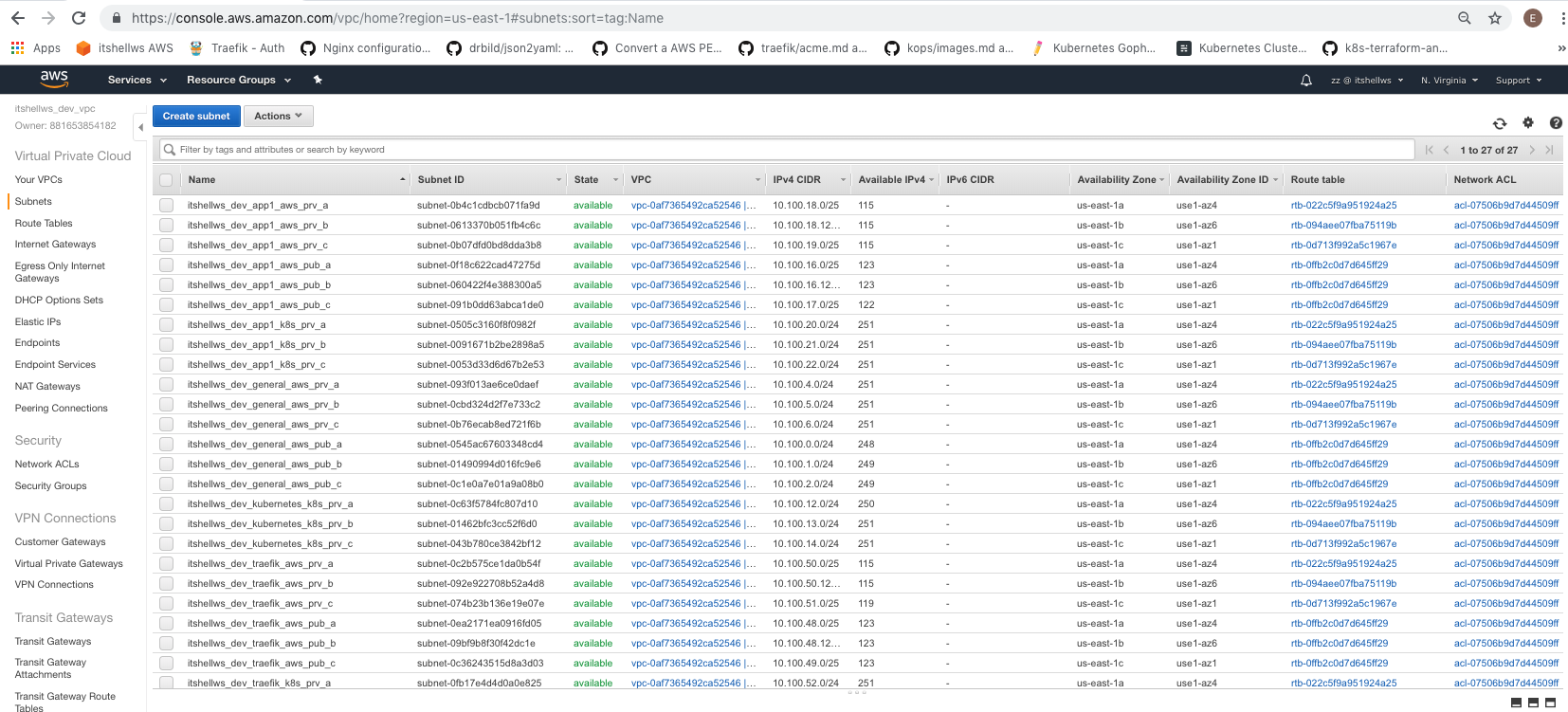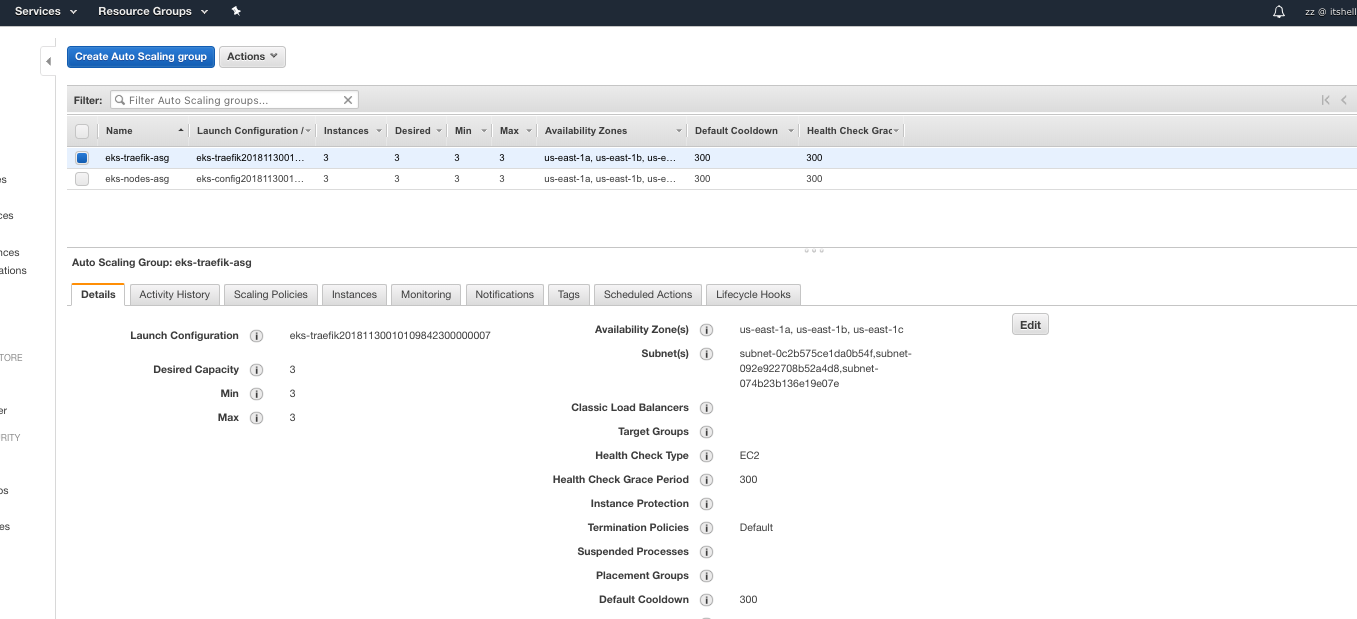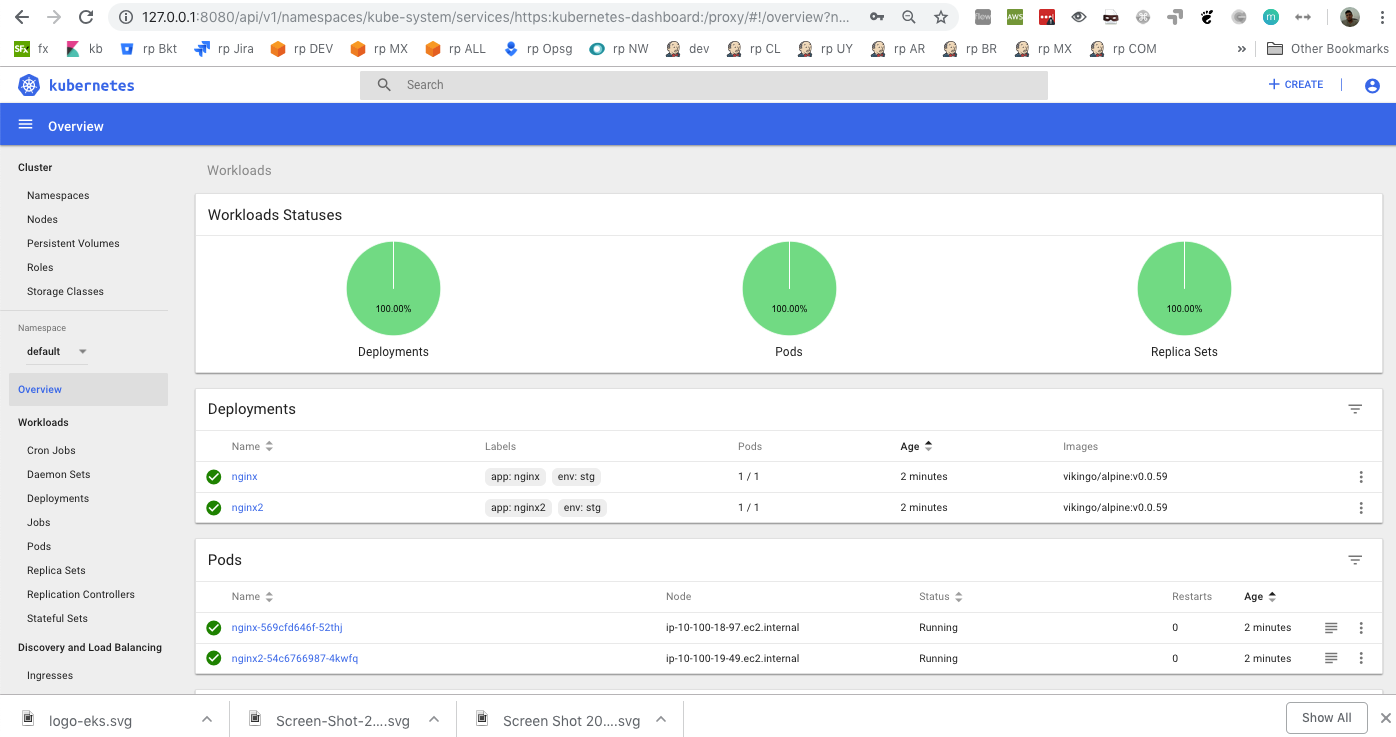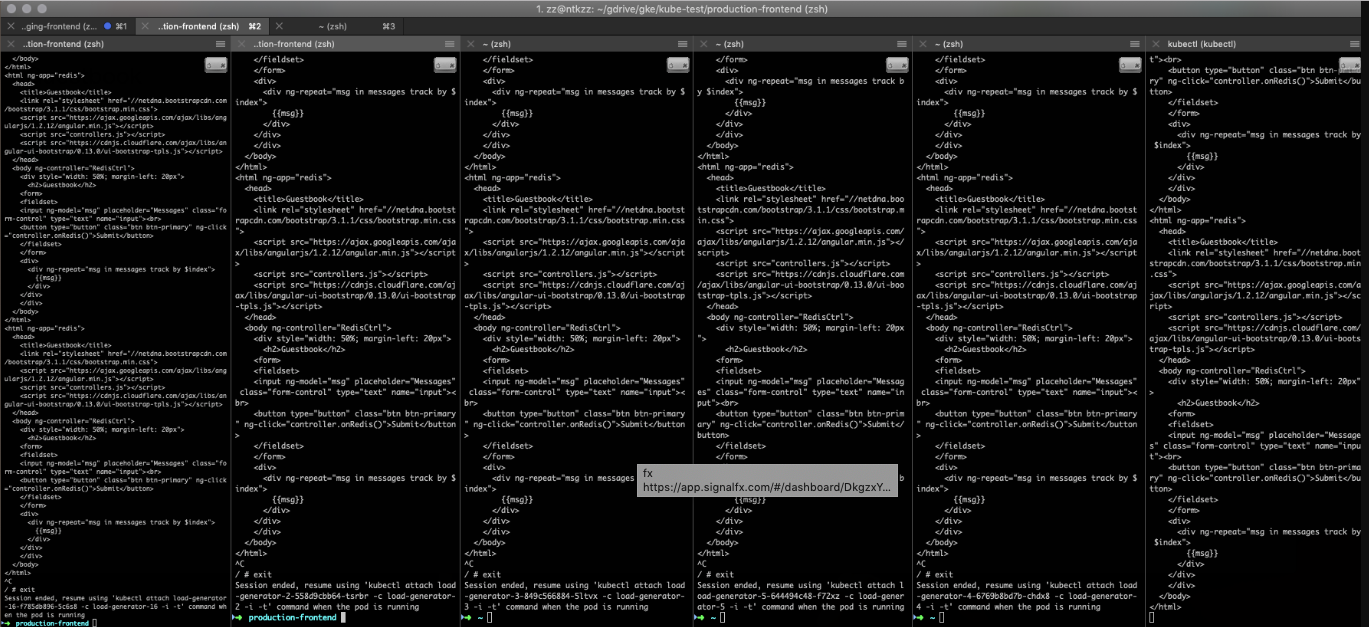### eks-terraform ###
Terraform module to install Kubernetes using EKS multi-az in AWS with autoscaling groups(tags) for Workers.
###EKS Cluster: Control Plane in multi AZ.
###Autoscaling Groups for Workers with NODEGROUP/PLACEMENT_CONSTRAINT.
###Iam Roles and Policies.
###Aws Integration to create a ELB,NLB,ALB in public subnets.
###VPC, Multiple subnets, public subnets, private subnets, internet gateway and nat gateways.
###NOTE: Check Amazon CNI ips support for instance type. https://docs.aws.amazon.com/AWSEC2/latest/UserGuide/using-eni.html#AvailableIpPerENI
Example AWS-CNI
c4.xlarge 4interfaces ips 15 15 containers x instance
m4.large 2interfaces ips 10 10 containers x instance
r4.large 3interfaces ips 10 10 containers x instance
Testing AWS-CNI plugin with t2.medium support 17 ips, When need create a ip number 18 fails the cni for instance cni limits.

Installation:
1- You need configure : s3 bucket for tfstate in main.tf aws_region,aws_profile,key,domain_name,reverse_zone,vpc-cidr,subnets in terraform.tfvars
2- Launch Terraform: terraform init terraform plan terraform apply -auto-approve
3- Wait 10 minutes and save the first part of output in file :
eks-config-auth.yml
apiVersion: v1
kind: ConfigMap
metadata:
name: aws-auth
namespace: kube-system
data:
mapRoles: |
- rolearn: arn:aws:iam::881653854182:role/eks-nodes
username: system:node:{{EC2PrivateDNSName}}
groups:
- system:bootstrappers
- system:nodes
4- Load cluster configuration in .kube/config to access the cluster.
aws eks update-kubeconfig --name eks-cluster --profile virginia-kubernetes
5- Apply eks-config-auth to permit workers registration in EKS-CLUSTER.
kubectl create -f eks-config-auth.yml
6- Check nodes registration
➜ eks-up-and-running k get nodes --label-columns group
NAME STATUS ROLES AGE VERSION GROUP
ip-10-100-18-161.ec2.internal Ready <none> 4s v1.10.3 node
ip-10-100-18-97.ec2.internal Ready <none> 0s v1.10.3 node
ip-10-100-50-11.ec2.internal Ready <none> 3s v1.10.3 traefik
ip-10-100-50-235.ec2.internal Ready <none> 1s v1.10.3 traefik
7- Test autoscaling workers groups changing desired and max.
wait 1 minute and check nodes to look the correctly registration.
➜ eks-up-and-running k get nodes --label-columns group
NAME STATUS ROLES AGE VERSION GROUP
ip-10-100-18-161.ec2.internal Ready <none> 14m v1.10.3 node
ip-10-100-18-97.ec2.internal Ready <none> 14m v1.10.3 node
ip-10-100-19-49.ec2.internal Ready <none> 9m v1.10.3 node
ip-10-100-50-11.ec2.internal Ready <none> 14m v1.10.3 traefik
ip-10-100-50-235.ec2.internal Ready <none> 14m v1.10.3 traefik
ip-10-100-51-22.ec2.internal Ready <none> 9m v1.10.3 traefik
8- Check dns-service is success.
➜ eks-up-and-running k get po --all-namespaces
NAMESPACE NAME READY STATUS RESTARTS AGE
kube-system aws-node-2lg6j 1/1 Running 0 10s
kube-system aws-node-d98q2 1/1 Running 0 6s
kube-system aws-node-n9lhz 1/1 Running 0 7s
kube-system aws-node-ngwfb 1/1 Running 0 9s
kube-system kube-dns-64b69465b4-js5km 0/3 ContainerCreating 0 6m
kube-system kube-proxy-kqs7f 1/1 Running 0 10s
kube-system kube-proxy-mmn2l 1/1 Running 0 9s
kube-system kube-proxy-rjjnq 1/1 Running 0 6s
kube-system kube-proxy-vssqc 1/1 Running 0 7s
9- Install helm and tiller.
cd eks-up-and-running
kubectl create serviceaccount --namespace kube-system tiller
kubectl create clusterrolebinding tiller-cluster-rule --clusterrole=cluster-admin --serviceaccount=kube-system:tiller
helm init --service-account tiller --upgrade
10- Install HPA-metrics server.
➜ eks-metrics mkdir eks-metrics
➜ eks-metrics cd eks-metrics
➜ eks-metrics git clone https://github.com/kubernetes-incubator/metrics-server.git
You need change this file metrics-server-deployment.yaml and add this line to fix eks2 to works metrics-server:
command:
- /metrics-server
- --kubelet-preferred-address-types=InternalIP
➜ eks-metrics vi metrics-server/deploy/1.8+/metrics-server-deployment.yaml
---
apiVersion: v1
kind: ServiceAccount
metadata:
name: metrics-server
namespace: kube-system
---
apiVersion: extensions/v1beta1
kind: Deployment
metadata:
name: metrics-server
namespace: kube-system
labels:
k8s-app: metrics-server
spec:
selector:
matchLabels:
k8s-app: metrics-server
template:
metadata:
name: metrics-server
labels:
k8s-app: metrics-server
spec:
serviceAccountName: metrics-server
volumes:
# mount in tmp so we can safely use from-scratch images and/or read-only containers
- name: tmp-dir
emptyDir: {}
containers:
- name: metrics-server
image: k8s.gcr.io/metrics-server-amd64:v0.3.1
imagePullPolicy: Always
command:
- /metrics-server
- --kubelet-preferred-address-types=InternalIP
volumeMounts:
- name: tmp-dir
mountPath: /tmp
git diff to look changes in metrics-server-deployment.yaml
➜ metrics-server git:(master) ✗ git diff
--- a/deploy/1.8+/metrics-server-deployment.yaml
+++ b/deploy/1.8+/metrics-server-deployment.yaml
@@ -31,6 +31,9 @@ spec:
- name: metrics-server
image: k8s.gcr.io/metrics-server-amd64:v0.3.1
imagePullPolicy: Always
+ command:
+ - /metrics-server
+ - --kubelet-preferred-address-types=InternalIP
volumeMounts:
- name: tmp-dir
mountPath: /tmp
(END)
➜ eks-metrics k create -f metrics-server/deploy/1.8+
clusterrole.rbac.authorization.k8s.io "system:aggregated-metrics-reader" created
clusterrolebinding.rbac.authorization.k8s.io "metrics-server:system:auth-delegator" created
rolebinding.rbac.authorization.k8s.io "metrics-server-auth-reader" created
apiservice.apiregistration.k8s.io "v1beta1.metrics.k8s.io" created
serviceaccount "metrics-server" created
deployment.extensions "metrics-server" created
service "metrics-server" created
clusterrole.rbac.authorization.k8s.io "system:metrics-server" created
clusterrolebinding.rbac.authorization.k8s.io "system:metrics-server" created
➜ eks-metrics k top nodes
NAME CPU(cores) CPU% MEMORY(bytes) MEMORY%
ip-10-100-18-108.ec2.internal 19m 1% 320Mi 16%
ip-10-100-19-76.ec2.internal 16m 1% 359Mi 18%
ip-10-100-50-18.ec2.internal 19m 1% 368Mi 19%
ip-10-100-50-231.ec2.internal 15m 1% 338Mi 17%
11- Launch kubernetes-dashboard and 2 applications , 1 public application with ELB and 1 private application.
cd eks-up-and-running
➜ eks-up-and-running k create -f eks-app-autoscaling
horizontalpodautoscaler.autoscaling "nginx" created
deployment.extensions "nginx" created
service "nginx" created
deployment.extensions "nginx2" created
service "nginx2" created
➜ eks-app-autoscaling k get svc -owide
NAME TYPE CLUSTER-IP EXTERNAL-IP PORT(S) AGE SELECTOR
kubernetes ClusterIP 172.20.0.1 <none> 443/TCP 42m <none>
nginx LoadBalancer 172.20.71.17 <pending> 80:30417/TCP 1m app=nginx,env=stg
nginx2 ClusterIP 172.20.30.143 <none> 80/TCP 6m app=nginx,env=stg
➜ eks-app-autoscaling k get svc -owide
NAME TYPE CLUSTER-IP EXTERNAL-IP PORT(S) AGE SELECTOR
kubernetes ClusterIP 172.20.0.1 <none> 443/TCP 42m <none>
nginx LoadBalancer 172.20.71.17 afe917206f44011e8abc402ddbc5496a-1082087107.us-east-1.elb.amazonaws.com 80:30417/TCP 2m app=nginx,env=stg
nginx2 ClusterIP 172.20.30.143 <none> 80/TCP 6m app=nginx,env=stg
Open the url using the FQDN detailed in EXTERNAL-IP.
12- Launch Kubernetes-dashboard and get token.
➜ eks-up-and-running k create -f eks-dashboard
secret "kubernetes-dashboard-certs" created
serviceaccount "kubernetes-dashboard" created
role.rbac.authorization.k8s.io "kubernetes-dashboard-minimal" created
rolebinding.rbac.authorization.k8s.io "kubernetes-dashboard-minimal" created
deployment.apps "kubernetes-dashboard" created
service "kubernetes-dashboard" created
kubectl proxy --port=8080 --address='0.0.0.0' --disable-filter=true &
➜ eks-dashboard aws-iam-authenticator token -i eks-cluster
{"kind":"ExecCredential","apiVersion":"client.authentication.k8s.io/v1alpha1","spec":{},"status":{"token":"k8s-aws-v1.aHR0cHM6Ly9zdHMuYW1hem9uYXdzLmNvbS8_QWN0aW9uPUdldENhbGxlcklkZW50aXR5JlZlcnNpb249MjAxMS0wNi0xNSZYLUFtei1BbGdvcml0aG09QVdTNC1ITUFDLVNIQTI1NiZYLUFtei1DcmVkZW50aWFsPUFLSUFKR05UNlRRMk9WSE1CMldRJTJGMjAxODExMzAlMkZ1cy1lYXN0LTElMkZzdHMlMkZhd3M0X3JlcXVlc3QmWC1BbXotRGF0ZT0yMDE4MTEzMFQwMTU0NTZaJlgtQW16LUV4cGlyZXM9NjAmWC1BbXotU2lnbmVkSGVhZGVycz1ob3N0JTNCeC1rOHMtYXdzLWlkJlgtQW16LVNpZ25hdHVyZT1jNjBlNTljYzI2ZmY5MzIyMDJlZGYzMGRiODAzMzc5MzE4NjgwMjY3ZGQyMDNiYmE2NTBkM2I2NzBhOTM3OGQy"}}
Open dashboard url in your browser using kube-proxy in port 8080 and use the token auth.
Look the dashboard.
13- You can configure hpa and testing the applications with load average.
cd eks-app-autoscaling
➜ eks-app-autoscaling git:(master) ✗ cat autoscaling.yml
---
apiVersion: autoscaling/v1
kind: HorizontalPodAutoscaler
metadata:
name: nginx
spec:
scaleTargetRef:
apiVersion: extensions/v1beta1
kind: Deployment
name: nginx
minReplicas: 30
maxReplicas: 35
targetCPUUtilizationPercentage: 30
➜ eks-app-autoscaling git:(master) ✗ k apply -f autoscaling.yml
➜ eks-app-autoscaling git:(master) ✗ k get hpa
NAME REFERENCE TARGETS MINPODS MAXPODS REPLICAS AGE
nginx Deployment/nginx 2%/30% 30 35 30 3h
14- I created the configuration to install traefik in EKS with simple auth to dashboard access.
cd eks-traefik
#CREATE USER WITH SIMPLE AUTH
htpasswd -c ./auth zz1
cat auth
kubectl create secret generic mysecret --from-file auth --namespace=kube-system
#CREATE ROLE TRAEFIK ACCESS-READ THE k8s METADATA
➜ eks-traefik kubectl create serviceaccount --namespace kube-system traefik-ingress-controller
➜ eks-traefik kubectl create clusterrolebinding traefik-cluster-rule --clusterrole=cluster-admin --serviceaccount=kube-system:traefik-ingress-controller
k apply -f .
➜ eks-traefik git:(master) ✗ k create -f .
configmap "traefik-conf" created
serviceaccount "traefik-ingress-controller" created
deployment.extensions "traefik-ingress-controller" created
ingress.extensions "traefik-ingress-service-admin" created
service "traefik-ingress-service-admin" created
service "traefik-ingress-service" created
#Login to traefik-dashboard and k8s-dashboard with simple-auth

#Look traefik-dashboard reading k8s-metadata

THANKS for use this repo!!!
https://github.com/anmolnagpal/terraform-eks
https://github.com/terraform-aws-modules/terraform-aws-eks
https://www.iheavy.com/2018/07/31/how-to-setup-an-amazon-eks-demo-with-terraform/
https://github.com/christopherhein/terraform-eks
https://github.com/howdio/terraform-aws-eks
https://www.terraform.io/docs/providers/aws/guides/eks-getting-started.html
https://aws.amazon.com/es/blogs/opensource/horizontal-pod-autoscaling-eks/









